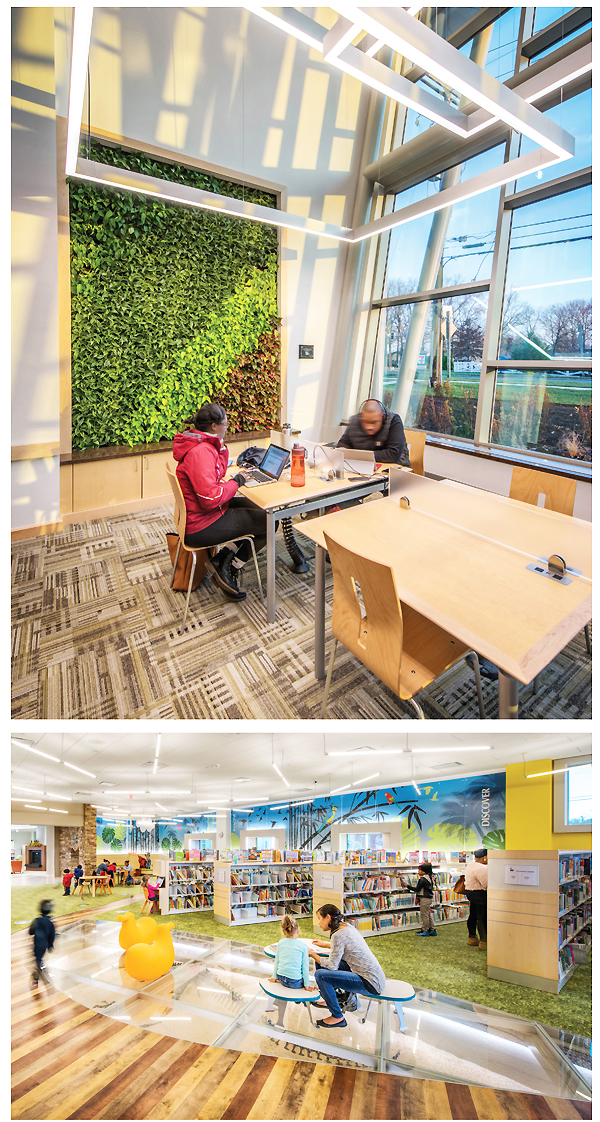Good Bones | Library Design
The key notes of the Laurel Branch Library—transparency and playfulness—work together
 In the Prince George’s County Memorial Library System, MD, the Laurel Branch Stanley Memorial Library was one of the busiest in the system, with the highest circulation per square foot. It served for nearly half a century, before closing to make room for not a renovation but a completely new building on the same spot.
In the Prince George’s County Memorial Library System, MD, the Laurel Branch Stanley Memorial Library was one of the busiest in the system, with the highest circulation per square foot. It served for nearly half a century, before closing to make room for not a renovation but a completely new building on the same spot.
Related Articles: |
The site itself is located in historic Emancipation Park. To make room to increase the size of the branch, the library worked out a deal with the city of Laurel: swap some of the park property with the library system in exchange for county-funded improvements to the park. These include a colorful playground, basketball courts, an amphitheater, a picnic pavilion, landscaping, and Americans with Disabilities Act–friendly circulation paths, as well as an interactive water feature.
Opening up
The design of the new space makes the most of that close collaboration, embracing “its place in the community through transparency” and “dissolving the barriers between interior and exterior,” according to architects Grimm & Parker. The new 31,000 square foot structure features a self-explanatory open plan that doesn’t rely on signage to navigate, high ceilings, and plenty of glass to maximize “connections between the interior space, landscape, and surrounding community,” the American Institute of Architects (AIA) said in honoring the project with a 2018 AIA/ALA (American Library Association) Library Building Award. (For those on the go, one very literal connection between inside and out is the drive-up book drop.)
|
|
|
NO OUTER LIMITS The Laurel Branch’s exterior highlights the theme of transparency and connects patrons to Emancipation Park. Photo ©Sam Kittner |
That said, the library doesn’t lack for defined interior spaces where they’re needed. Private study and conference rooms are joined by a gaming room; computer lab; adult, teen, and children’s reading areas; and a café separated by a (what else?) glass partition from the lobby. And within those larger spaces, still smaller ones have been imaginatively outlined, particularly in the youth areas. A hidden reading nook, disguised as a dinosaur’s rib cage, overlooks an adjoining pathway, linking the library to the park.
(Pre)historic roots
The entire children’s area is dinosaur-themed, celebrating the discovery of dinosaur fossils in the Muirkirk area of South Laurel. Glowing LED dinosaur footprints lead to a cavelike entry through a stone wall, a seating island is shaped like a volcano, and baby saber-toothed cats’ footprints climb the walls. The piece de resistance is, again, framed by the transparency of glass: a full-size Nanotyrannus fossil replica lies in sand beneath a glass floor. For adults, a double-sided fireplace provides see-thru comfort.
|
|
|
DISCOVERING NATURE (l.–r.): The Whispering Room’s living green wall brings the surrounding park inside and exemplifies the project’s commitment to sustainability. In a nod to local (pre)history, the Laurel Branch’s Discovery Island features a dinosaur theme whose crowning glory is a full-size Nanotyrannus fossil replica beneath a glass floor. Photos ©Sam Kittner |
Sustainable choices
But the Laurel Branch’s connection to nature is more than just for fun. While the library chose not to pursue Leadership in Energy and Environmental Design (LEED) certification, LEED still provided the “overarching design framework for its sustainable features.” The design boasts a permeable pavement parking lot, storm water management gardens, electric vehicle charging stations, solar cells on the roof, and a living green wall. The library can run the lobby’s electricity, heat, and air conditioning separately from the rest of the building via a generator, to provide a refuge for the community in times of natural disaster.
Outside, AIA called the site “a living laboratory” featuring native drought-resistant plants set in large sweeps for maximum visual and functional impact. Flowering cherry trees echo nearby Washington, DC, and native oaks reference the history of the site, once known as Oak Grove.
Overcoming challenges
The project’s process was not without some controversy. When the library proposed dropping “Stanley Memorial” from the name of the new construction, some locals objected. Others took issue with the objections, pointing out that the namesake had been a member of the Confederate Army, something they found particularly inappropriate in light of the branch’s location in Emancipation Park and in the historically African American neighborhood the Grove. The trustees eventually reversed their decision and kept the name “Laurel Branch Library, Stanley Memorial Library” on the structure, though the second part is not generally used. The project, which had been on the books since 2005 and was originally scheduled to break ground in October 2013, saw delays of about a year, in part because of an initial requirement that it be built with union labor. Owing to competing projects, not enough such labor could be identified at a price that would keep the project on its $14 million budget, according to local officials; ultimately a nonunion contractor, NARDI Construction, was selected.
Despite these hiccups, when the branch reopened in late November 2016, three years after it shuttered and moved to a temporary site, hundreds of people attended, and the Baltimore Sun reported universal delight on the part of patrons at the changes to library and park alike. When it comes to exceeding expectations, this is one library that doesn’t rest on its laurels.
RELATED
ALREADY A SUBSCRIBER? LOG IN
We are currently offering this content for free. Sign up now to activate your personal profile, where you can save articles for future viewing











Add Comment :-
Comment Policy:
Comment should not be empty !!!